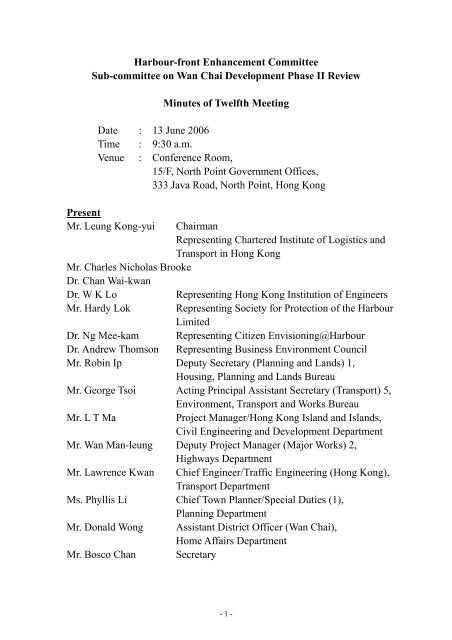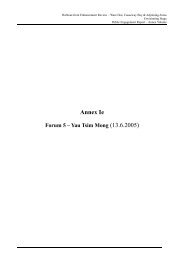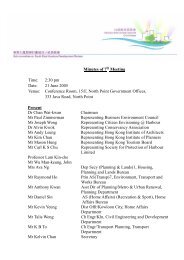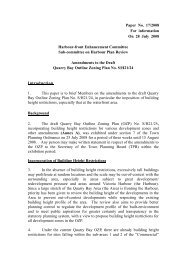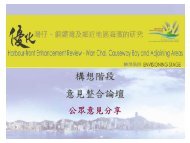PDF Format - Our Harbour Front
PDF Format - Our Harbour Front
PDF Format - Our Harbour Front
You also want an ePaper? Increase the reach of your titles
YUMPU automatically turns print PDFs into web optimized ePapers that Google loves.
<strong>Harbour</strong>-front Enhancement Committee<br />
Sub-committee on Wan Chai Development Phase II Review<br />
Minutes of Twelfth Meeting<br />
Date : 13 June 2006<br />
Time : 9:30 a.m.<br />
Venue : Conference Room,<br />
15/F, North Point Government Offices,<br />
333 Java Road, North Point, Hong Kong<br />
Present<br />
Mr. Leung Kong-yui<br />
Chairman<br />
Representing Chartered Institute of Logistics and<br />
Transport in Hong Kong<br />
Mr. Charles Nicholas Brooke<br />
Dr. Chan Wai-kwan<br />
Dr. W K Lo<br />
Representing Hong Kong Institution of Engineers<br />
Mr. Hardy Lok Representing Society for Protection of the <strong>Harbour</strong><br />
Limited<br />
Dr. Ng Mee-kam Representing Citizen Envisioning@<strong>Harbour</strong><br />
Dr. Andrew Thomson Representing Business Environment Council<br />
Mr. Robin Ip Deputy Secretary (Planning and Lands) 1,<br />
Housing, Planning and Lands Bureau<br />
Mr. George Tsoi Acting Principal Assistant Secretary (Transport) 5,<br />
Environment, Transport and Works Bureau<br />
Mr. L T Ma<br />
Project Manager/Hong Kong Island and Islands,<br />
Civil Engineering and Development Department<br />
Mr. Wan Man-leung Deputy Project Manager (Major Works) 2,<br />
Mr. Lawrence Kwan<br />
Highways Department<br />
Chief Engineer/Traffic Engineering (Hong Kong),<br />
Transport Department<br />
Ms. Phyllis Li Chief Town Planner/Special Duties (1),<br />
Planning Department<br />
Mr. Donald Wong Assistant District Officer (Wan Chai),<br />
Home Affairs Department<br />
Mr. Bosco Chan Secretary<br />
- 1 -
In Attendance<br />
Ms. Lydia Lam Assistant Secretary (Planning) 3,<br />
Housing, Planning and Lands Bureau<br />
Mr. S K Lam Chief Engineer/Hong Kong (2),<br />
Civil Engineering and Development Department<br />
Ms. Iris Tam<br />
Representing City Planning Consultants Ltd<br />
Miss Flora Lai Representing City Planning Consultants Ltd<br />
Dr. Sujata S Govada Representing City Planning Consultants Ltd<br />
Mr. Dickson Lo Representing Maunsell Consultants Asia Ltd<br />
Absent with Apologies<br />
Mr. Stephen Chan<br />
Mr. Steve Chan<br />
Dr. Alvin Kwok<br />
Mr. Patrick Lau<br />
Representing The Conservancy Association<br />
Welcome message<br />
Action<br />
1. The Chairman welcomed Dr. W K Lo to attend the meeting.<br />
Item 1<br />
Confirmation of minutes of last meeting<br />
1.1 The revised draft minutes of the 11th meeting held on 20<br />
April 2006 and the Special Meeting held on 8 May 2006,<br />
both of which were circulated on 9 June 2006, were<br />
confirmed with no amendment.<br />
Item 2<br />
Matters Arising<br />
2.1 Regarding the billboard that was erected near the Cross<br />
<strong>Harbour</strong> Tunnel approach at the corner of Wan Shing Street,<br />
Mr. Robin Ip reported that the tenancy of the billboard was<br />
managed by Lands Department (LandsD) and would be<br />
renewed after the expiry of the current lease. He said that<br />
LandsD had the responsibilities to ensure that government<br />
revenue was maintained through renewal of existing<br />
- 2 -
short-term tenancies. When considering new short-term<br />
tenancies involving erection of billboard along the<br />
harbour-front, LandsD would consult <strong>Harbour</strong>-front<br />
Enhancement Committee (HEC) beforehand.<br />
2.2 Mr. Charles Nicholas Brooke indicated that while LandsD<br />
had the responsibility to maximize government’s revenue, the<br />
Sub-committee had the responsibility to enhance the<br />
waterfront. He supported the idea of LandsD approaching<br />
HEC for short-term tenancies involving erection of billboard<br />
along the harbour-front. He opined that LandsD should<br />
make reference to the <strong>Harbour</strong> Planning Principles when<br />
considering new applications for short-term tenancies. In<br />
response, Mr. Robin Ip said that representatives from<br />
LandsD had already briefed members of the HEC regarding<br />
the processing of applications for short-term tenancies. He<br />
remarked that LandsD was aware of the concern of members<br />
from HEC and would consult them on new applications along<br />
the harbour-front and which would have visual impact to the<br />
harbour.<br />
Item 3<br />
Outcome of Further Engagement and Concept Plan<br />
Preparation Work<br />
3.1 The Chairman reported that the paper for discussion under<br />
the item summarized the outcome of the further engagement<br />
with Town Planning Board (TPB), relevant District Councils<br />
(DCs), Legislative Council (LegCo) and professional<br />
institutions. These further engagements were attended by<br />
the Chairman and/or the Secretariat of the Sub-committee<br />
together with relevant government officials.<br />
3.2 Mr. Robin Ip supplemented that the Sub-committee had<br />
already discussed in details the report “Trunk Road<br />
Alignments & <strong>Harbour</strong>-front Enhancement” that was<br />
prepared by the consultants and endorsed the approach for<br />
proceeding with the Realization Stage of the <strong>Harbour</strong>-front<br />
Enhancement Review – Wan Chai, Causeway Bay and<br />
Adjoining Areas (HER) project to further engage TPB,<br />
- 3 -
elevant DCs, LegCo and professional institutions. He<br />
highlighted the following points on the outcome of the further<br />
engagement.<br />
• For the alignment of the Trunk Road, there was a general<br />
support for Variation 1 of the Tunnel Option.<br />
• The Sub-committee had accepted the recommendation of<br />
the Expert Panel on Sustainable Transport Planning and<br />
Central – Wan Chai Bypass that there was a compelling and<br />
present need to build the Trunk Road.<br />
• All possible alignments for the Trunk Road would require<br />
some reclamation at the eastern and western ends.<br />
• The government would ensure that any proposed<br />
reclamation could meet the overriding public need (OPN)<br />
test and comply with the requirements under the Protection<br />
of the <strong>Harbour</strong> Ordinance (PHO).<br />
• The government would also take into account the economic,<br />
environmental and social factors and any reclamation<br />
should be the minimum required to satisfy the OPN test.<br />
• Variation 1 of the Tunnel Option was considered superior to<br />
Variation 2 and 3 in respect of compliance with the<br />
requirements under the OPN test, time for construction,<br />
construction cost and impact on existing traffic during<br />
construction.<br />
• For the Flyover Option, apart from the actual land that<br />
would be formed by reclamation, the affected area of the<br />
Victoria <strong>Harbour</strong> would have to be considered under the<br />
principle of protecting and preserving the <strong>Harbour</strong>. In<br />
addition, the visual impact to the Causeway Bay Typhoon<br />
Shelter and ex-Public Cargo Working Area would need to<br />
be considered for the Flyover Option.<br />
Based on the above considerations, Mr. Robin Ip hoped that<br />
members would agree to instruct the consultants to adopt<br />
Variation 1 of the Tunnel Option as the basis for preparing<br />
Concept Plan for public engagement at the Realization Stage.<br />
3.3 Mr. George Tsoi remarked that from transport point of view,<br />
the performance of the Flyover Option and the three<br />
variations of the Tunnel Option were comparable in that all of<br />
them were able to provide the planned slip roads for<br />
- 4 -
enhancing the performance of the Trunk Road. He<br />
highlighted the importance of considering the impact to the<br />
existing traffic during the construction period of the Trunk<br />
Road. He indicated that the impact would be the least under<br />
Variation 1 of the Tunnel Option while Variation 2 of the<br />
Tunnel Option would require major temporary traffic<br />
diversion at the Cross <strong>Harbour</strong> Tunnel approach which might<br />
not be acceptable by the public. The Flyover Option would<br />
also have major impact to the existing traffic at the<br />
connection with the Island Eastern Corridor. Based on the<br />
anticipated impact to the existing traffic, he supported the<br />
proposal of adopting Variation 1 of the Tunnel Option to<br />
serve as the basis for preparing the Concept Plan.<br />
3.4 Mr. L T Ma briefed members on the outcome of the further<br />
engagement with TPB, relevant DCs, LegCo and professional<br />
institutions. In addition, the Government had also consulted<br />
the Transport Advisory Committee (TAC).<br />
(i) TPB -<br />
In the briefing on 21 April 2006, there was view from<br />
TPB members that the Flyover Option would unlikely be<br />
acceptable to the general public and that Variation 1 of<br />
the Tunnel Option would be the most viable option.<br />
Government and the consultants were advised to clearly<br />
explain the merits of Variation 1 to the public with a<br />
view to soliciting the widest possible community<br />
support.<br />
(ii) DCs -<br />
Eastern, Southern, Wan Chai and Central & Western DCs<br />
were consulted in May 2006. There were quite a<br />
number of DC members urging for the early completion<br />
of the Trunk Road. For the construction form of the<br />
Trunk Road, there was a majority support for Variation 1<br />
of the Tunnel Option in the Southern DC and there were<br />
also supporting views for this variation from the other<br />
three DCs. There was very little support for the<br />
Flyover Option. Disruption to traffic was a main<br />
concern. Some DC members were of the view that<br />
- 5 -
maximum opportunities should be provided to<br />
harbour-front enhancement but were aware that<br />
harbour-front enhancement should not be a reason for<br />
reclamation in the <strong>Harbour</strong>. DC members were also<br />
aware that the recommendations from the consultants<br />
would need to pass the OPN test and comply with the<br />
requirements under the PHO. The Central & Western<br />
DC passed a motion objecting to the conclusion of no<br />
possible “no reclamation” alignment and requesting the<br />
Administration to review the planning for Central and<br />
Wan Chai and to reduce the commercial development in<br />
Central Reclamation Phase III and Tamar Development<br />
so as to minimize the transport need.<br />
(iii) LegCo Panel on Planning, Lands and Works (PLW) -<br />
There was no discussion after the Consultants’<br />
presentation due to insufficient time at the meeting on 23<br />
May 2006. A special meeting was held on 9 June 2006<br />
at which the consultants explained that in view of the<br />
connections of the Trunk Road with the existing road<br />
network and the planned slip roads; and the constraints<br />
imposed by the Tsuen Wan Line of the Mass Transit<br />
Railway, certain amount of reclamation would be<br />
required for the construction of the Trunk Road. There<br />
was supporting view for Variation 1 of the Tunnel<br />
Option. There was also view that a water theme on the<br />
formed land could reduce the impact brought about by<br />
reclamation. A second special meeting would be held<br />
on 26 June 2006 to receive deputations’ views.<br />
(iv) Professional Institutions -<br />
In the Joint Institute Seminar on 20 May 2006 organized<br />
by Hong Kong Institute of Architects, Hong Kong<br />
Institution of Engineers, Hong Kong Institute of<br />
Landscape Architects, Hong Kong Institute of Planners<br />
and Hong Kong Institute of Surveyors, there was a<br />
general support for Variation 1 of the Tunnel Option as<br />
the most feasible solution taking note of the<br />
requirements of the PHO.<br />
- 6 -
(v) TAC -<br />
TAC reiterated their full support for the construction of<br />
the Trunk Road together with the planned slip roads in<br />
Wan Chai and Causeway Bay. TAC hoped that this last<br />
piece of infrastructure of the strategic road link along the<br />
northern shore of Hong Kong Island could be completed<br />
as early as possible. It was emphasized that traffic<br />
disruption during the construction of the Trunk Road<br />
should be kept to the minimum. TAC members realized<br />
that the consultants had recommended the option for the<br />
Trunk Road that required the minimum amount of<br />
reclamation while allowing the maximum opportunity<br />
for harbour-front enhancement on the land formed for<br />
the Trunk Road.<br />
He stressed that the requirements under the PHO were very<br />
stringent and that the Government would be subject to legal<br />
challenge under the law if an option with similar performance<br />
but required less reclamation is not proposed. Since<br />
Variation 1 of the Tunnel Option would require the least<br />
amount of reclamation and that it had received general<br />
support from the community, he hoped that the<br />
Sub-committee could agree adopting Variation 1 of the<br />
Tunnel Option for the Concept Plan preparation in the<br />
Realization Stage. Based on the amount of land formed<br />
under this variation, the consultants would devise different<br />
themes of land use proposals and harbour-front enhancement<br />
ideas, including the water theme proposed by a LegCo<br />
member at the LegCo PLW Panel meeting held on 9 June<br />
2006. He further pointed out that an environmental<br />
assessment in accordance with the requirements of the<br />
Environmental Impact Assessment Ordinance (EIAO) would<br />
be carried out at the same time with the preparation of<br />
Concept Plan. Hence, submission of project profile for EIA<br />
study brief would have to be published in newspapers. He<br />
finally said that physical models, photomontages and<br />
computer animations would be prepared to assist the public in<br />
visualizing the planning concepts and be presented in the<br />
public engagement activities for the Realization Stage.<br />
- 7 -
3.5 Ms. Phyllis Li stated that the Tunnel Option would have less<br />
visual and environmental impact to the harbour-front and<br />
would affect less area of the harbour compared with the<br />
Flyover Option. In addition, she opined from a planning<br />
perspective that the Tunnel Option would perform better in<br />
providing connectivity and accessibility to the harbour-front.<br />
She said that Planning Department supported adopting<br />
Variation 1 of the Tunnel Option as a basis for preparing the<br />
Concept Plan.<br />
3.6 Dr. W K Lo supplemented that the Joint Institute Seminar<br />
held on 20 May 2006 had a general consensus on the need of<br />
the Trunk Road and the planned slip roads at Wan Chai and<br />
Causeway Bay and that Variation 1 of the Tunnel Option was<br />
considered to be the most feasible solution. He remarked<br />
that the Hong Kong Institution of Engineers had reflected to<br />
the LegCo 2 years ago that the Trunk Road was required to<br />
alleviate the traffic problems. He added that the water<br />
theme on the formed land would be a good idea.<br />
3.7 Mr. Hardy Lok opined that the LegCo members should have<br />
been highlighted about issues listed in the Appendix of the<br />
Public Engagement Report. In response, Mr. Robin Ip<br />
explained that the paper submitted to the LegCo Panel<br />
members was very comprehensive, the Expert Panel Report<br />
and the Public Engagement Report were both attached to the<br />
panel paper. In fact, the LegCo members did raise questions<br />
on specific parts of the reports. Mr. L T Ma supplemented<br />
that the paper submitted to the LegCo Panel for the meeting<br />
on 23 May 2006 contained four appendices which included<br />
the Expert Panel Report, the Public Engagement Report of<br />
Envisioning Stage of HER together with its Annex Volume in<br />
a CD ROM, the Consultants’ Report on “Trunk Road<br />
Alignments & <strong>Harbour</strong>-front Enhancement” and a Summary<br />
to the Consultants’ Report. The paper for the special LegCo<br />
PLW Panel meeting on 9 June 2006 was prepared to provide<br />
the following additional information requested by LegCo.<br />
• Further details on the comparison among the various<br />
alignment and construction options for the Trunk Road.<br />
• Details and analysis of the views from different parties on<br />
- 8 -
the alignment and construction options for the Trunk<br />
Road.<br />
• The use of physical models to illustrate to the public the<br />
planning ideas for the Wan Chai Development Phase II<br />
Review.<br />
• In respect of the Tunnel Option for the Trunk Road, to<br />
consider covering the reclaimed land above the tunnel<br />
with water so as to visually increase the area of the sea<br />
surface.<br />
Mr. L T Ma opined that the 2 papers together had provided a<br />
comprehensive report of the discussions of the<br />
Sub-committee and the findings of the Consultants so far.<br />
3.8 The Chairman reiterated that the four appendices attached to<br />
the paper submitted to the LegCo PLW Panel were also<br />
circulated to TPB and the relevant DCs as appendices to the<br />
discussion papers.<br />
3.9 For the next step forward, the Chairman said that the<br />
consultants had to complete the Concept Plan with different<br />
harbour-front enhancement themes before the public<br />
engagement activities for the Realization Stage. When<br />
preparing the Concept Plan, the alignment and form of<br />
construction of the Trunk Road should have to be fixed for<br />
planning of harbour-front enhancement elements. He said<br />
that, in view of the consultants’ findings, the Flyover Option<br />
should not be accepted as a possible form of construction of<br />
the Trunk Road. He also remarked that the requirements<br />
under the PHO should be strictly complied with. He<br />
requested members to give their views on the proposal of<br />
adopting Variation 1 of the Tunnel Option as the basis for<br />
preparing the Concept Plan.<br />
3.10 Dr. Ng Mee-kam recollected that the majority of the<br />
participants in the charrettes of the Envisioning Stage<br />
preferred tunnel as an option for the Trunk Road. She<br />
pointed out that a set of sustainability principles and<br />
indicators had been established during the Envisioning Stage<br />
and suggested that information on comparison of the options<br />
using those sustainability principles and indicators should be<br />
- 9 -
provided.<br />
3.11 Dr. Chan Wai-kwan opined that as the alignment and form<br />
of construction for the Trunk Road had been settled, the focus<br />
should then be on harbour-front enhancement. Suitable<br />
proposals should be prepared for the public to choose. The<br />
Chairman said that based on the recent public engagement,<br />
there should already be two different themes, the traditional<br />
landscaping one and water theme one.<br />
3.12 Mr. Charles Nicholas Brooke indicated that there was a<br />
general consensus to drop the Flyover Option. On the other<br />
hand, he opined that the Sub-committee should take<br />
sustainable development, which would be for the benefits of<br />
the future generations, instead of minimum reclamation as the<br />
key consideration in preparing the Concept Plan. He<br />
suggested preparing Concept Plan based on all three<br />
variations of the Tunnel Option for public input. In<br />
response, Mr. Robin Ip emphasized that the Government had<br />
to comply with the requirements under the PHO and the OPN<br />
test. For this reason, Variation 1 of the Tunnel Option that<br />
would require the least amount of reclamation when<br />
compared with the other options should be adopted in<br />
preparing the Concept Plan.<br />
3.13 Dr. Chan Wai-kwan pointed out that the Trunk Road would<br />
affect the draft Wan Chai North Outline Zoning Plan (OZP)<br />
and the North Point OZP. He anticipated that residents of<br />
the North Point district would be concerned about<br />
harbour-front enhancement along the North Point shoreline<br />
and relevant materials should be prepared for response. He<br />
further indicated that a clear definition of reclamation,<br />
especially for cases like openable bridge, flyover, pile caps<br />
and floating pontoon, should be established before presenting<br />
the Concept Plan to the public.<br />
3.14 Mr. L T Ma reported that there were views from the DC<br />
members for extending the harbour-front enhancement both<br />
in the east and west directions, which would have to be<br />
prioritized for implementation. On the definition of<br />
- 10 -
eclamation, he indicated that further advice was being<br />
sought from DoJ with case-specific details provided to DoJ<br />
for their consideration.<br />
3.15 Dr. Andrew Thomson opined that it might not be appropriate<br />
to seek legal advice from DoJ on what constituted an<br />
overriding public need. He considered that public inputs<br />
were required instead, with appropriate stakeholders<br />
consulted. He opined that besides the suggested water<br />
theme, some form of reclamation compensation measures<br />
such as restoring part of the <strong>Harbour</strong> area might worth<br />
considering.<br />
3.16 In response to Dr. Andrew Thomson, Mr. Robin Ip said that<br />
the purpose of the Envisioning Stage of HER was to identify<br />
the need of the public. The compelling and present public<br />
need for building the Trunk Road to alleviate the traffic<br />
problems along the Connaught Road/Harcourt<br />
Road/Gloucester Road Corridor had been firmly established<br />
through the Expert Panel Forum organized by the<br />
Sub-committee. He added that the suggestion received was<br />
that the habour-front enhancement could include some form<br />
of a water feature.<br />
3.17 Mr. L T Ma added that the public had already expressed their<br />
wishes and desires during the public forums and charrettes of<br />
the Envisioning Stage of HER. The issue to be considered<br />
was whether their needs could pass the OPN test and comply<br />
with the requirements under the PHO. That was in such<br />
respect that further advice from DoJ would be needed.<br />
Regarding further public engagement, Mr. L T Ma said that<br />
workshops and town hall meeting would be convened at the<br />
Realization Stage. He said that the venue for these public<br />
engagement activities ought to be carefully selected for the<br />
convenience of the public to attend, in particular for those<br />
who would be directly affected by the project.<br />
3.18 The Chairman agreed that the need of the public had already<br />
been established through the public engagement process.<br />
He said that proposals and views like openable bridge and<br />
- 11 -
etaining the Causeway Bay Typhoon Shelter were initiated<br />
by the public. He indicated that these proposals and views<br />
had been fully considered by the Sub-committee with due<br />
regards to the requirements under the PHO. He pointed out<br />
that the “shallow water” idea that was originally raised by<br />
one of the Sub-committee members was further developed<br />
into an idea of covering the reclaimed land above the tunnel<br />
with water so as to visually increase the area of the sea<br />
surface. The latter idea could be further pursued. With<br />
regard to compliance with the OPN test, he opined that legal<br />
input would be required. Mr. Charles Nicholas Brooke<br />
remarked against relying wholly on legal advice.<br />
3.19 Dr. Ng Mee-kam said that during the public engagement<br />
activities in the Envisioning Stage, there was a strong desire<br />
from the public for water activities or close contact with<br />
water. According to the discussion so far, the provision of<br />
such water activities would require implementation of some<br />
works along the harbour and there might be cases where such<br />
works would contravene the requirements under the PHO.<br />
She opined that the PHO might have to be slightly amended<br />
to accommodate the implementation of such works for the<br />
provision of water activities that were strongly desired by the<br />
public. She added that the public also had a strong wish for<br />
a continuous easily accessible harbour-front promenade and<br />
would like to retain the heritage of the area. She suggested<br />
that the consultants should take those into account when<br />
preparing the Concept Plan. For sustainability assessment,<br />
she opined that the assessment should start for supporting the<br />
Concept Plan preparation work.<br />
3.20 Mr. L T Ma opined that, according to the assessment of the<br />
consultants, extent of reclamation under the three variations<br />
of the Tunnel Option were different, and under the<br />
requirements of the PHO, the option that would involve the<br />
least amount of reclamation would have to be adopted. He<br />
reiterated that the Government had to ensure that the adopted<br />
proposal would comply with the PHO. For those<br />
harbour-front enhancement ideas with doubt on compliance<br />
with the PHO, the approach adopted was to provide further<br />
- 12 -
details to DoJ for a well-informed advice. In some cases,<br />
for example the floating pontoon, decommissioning plan was<br />
submitted hoping that a clear, and hopefully a positive<br />
response would be provided by DoJ.<br />
3.21 In response to Dr. Ng Mee-kam’s point regarding amendment<br />
of the PHO, Mr. Robin Ip said that the Government had no<br />
intention to amend the PHO. He mentioned that the<br />
Government would proceed with the project in accordance<br />
with the PHO and the OPN test. All ideas for harbour-front<br />
enhancement would be considered in consultation with DoJ<br />
to ensure that they would comply with the PHO.<br />
3.22 Dr. W K Lo pointed out that apart from requiring the least<br />
area of reclamation, Variation 1 for the Tunnel Option was<br />
superior to the other 2 variations in many other respects such<br />
as construction cost, impact to existing traffic and<br />
construction time. Instead of just presenting only this<br />
variation to the public, he suggested that the other<br />
ideas/proposals that had been considered should also be<br />
presented with explanations on why they were not pursued.<br />
The Chairman agreed.<br />
3.23 The Chairman noted that the Government had no current<br />
plan to propose any amendment to the PHO. However, he<br />
opined that discussions during the HER project could provide<br />
some background for consideration if the opportunity arose in<br />
the future.<br />
3.24 Mr. Robin Ip reiterated that the Government had to ensure<br />
compliance with the requirements under the PHO. Since<br />
Variation 1 of the Tunnel Option would require the least<br />
extent of reclamation and was thus superior to the other<br />
options from the PHO perspective, he hoped that the<br />
Sub-committee could accept Variation 1 as the basis for<br />
preparing the Concept Plan.<br />
3.25 The Chairman said that the Sub-committee, as an advisory<br />
body to the Government on the WDII Review, should also<br />
ensure that their proposal could comply with the<br />
- 13 -
equirements under the PHO. When presenting the<br />
recommended proposal to the public, he agreed to the idea of<br />
explaining the drawbacks of those ideas/proposals that had<br />
been considered but decided not to be pursued. Dr. W K Lo<br />
shared the view of the Chairman.<br />
3.26 Mr. Charles Nicholas Brooke agreed in principle with the<br />
Chairman’s suggestion but reminded that members should<br />
avoid giving the wrong perception that the Sub-committee<br />
was making a decision for the community. He suggested<br />
presenting to the public that Variation 1 of the Tunnel Option<br />
was the preferred solution after considering the disadvantages<br />
of the other options.<br />
3.27 Ms. Phyllis Li said that the Concept Plan should be a legally<br />
sound as well as a good plan. She indicated that apart from<br />
the Trunk Road, the land uses, within the concerned areas<br />
would be covered to provide an integrated land use –<br />
transport planning framework. She said that opportunities<br />
would be taken to improve the accessibility of the<br />
harbour-front and that the Concept Plan should take into<br />
consideration the sustainability principles and indicators<br />
developed at the Envisioning Stage.<br />
3.28 The Chairman said that the impact on the North Point OZP<br />
should be explained together with the Concept Plan. He<br />
mentioned that connectivity and accessibility in addition to<br />
the vibrancy of the harbour-front should be the main focus<br />
when considering the ideas for harbour-front enhancement.<br />
3.29 Dr. Ng Mee-kam indicated that the Eastern DC had recently<br />
organized a waterfront design competition and suggested<br />
approaching the DC for the designs.<br />
3.30 Mr. Charles Nicholas Brooke suggested that when the<br />
Concept Plans were available, all HEC members should be<br />
invited to attend the meeting for considering them. The<br />
Chairman agreed.<br />
3.31 Dr. Chan Wai-kwan suggested that the HER Task Force<br />
- 14 -
should be prepared for the likely responses from the residents<br />
of the Eastern District. He shared the view of Dr. Ng<br />
Mee-kam to approach the Eastern DC regarding the results of<br />
their waterfront design competition and to consider inviting<br />
them to present their results at the HEC briefing. He opined<br />
that the public engagement activities for the Realization Stage<br />
could reach out to areas like the ex-Public Cargo Working<br />
Area, undeveloped area adjoining the Island Eastern Corridor<br />
in North Point or the A-king slipway site. In response to the<br />
Chairman, the meeting agreed that the Sub-committee,<br />
instead of the Task Force, would oversee the works of the<br />
consultants in preparing the Concept Plan.<br />
3.32 As members had no further comments, the Chairman<br />
concluded that the Consultants should proceed with preparing<br />
Concept Plan with different harbour-front enhancement<br />
themes based on Variation 1 of the Tunnel Option.<br />
Materials should also be prepared for explaining to the public<br />
why some of the proposals and options raised by the public<br />
were not adopted. A sustainability development assessment<br />
should also be conducted on the three variations of the<br />
Tunnel Option as well as the Flyover Option, based on the<br />
sustainability principles and indicators that were developed<br />
during the Envisioning Stage. The Chairman clarified that<br />
apart from conducting the sustainability development<br />
assessment, there was no need to further develop Variation 2<br />
and 3 of the Tunnel Option and the Flyover Option.<br />
3.33 In response to the Chairman, Ms. Iris Tam said that a board<br />
brush sustainability assessment for the 3 variations of the<br />
Tunnel Option and the Flyover Option could be conducted<br />
based on the information provided by the Consultants for the<br />
WDII Review with the supplement of certain assumptions.<br />
The meeting agreed with the approach.<br />
3.34 Mr. L T Ma suggested that a meeting around mid July 2006<br />
to review the consultants’ work.<br />
3.35 Mr. L T Ma further reported that results of the waterfront<br />
design competition organized by the Eastern DC had been<br />
- 15 -
obtained for reference.<br />
Item 4<br />
Any Other Business<br />
4.1 Mr. L T Ma said that the “quick win” project at the<br />
ex-PCWA was presented to the Wan Chai DC on 16 May<br />
2006. He added that DC members supported the project and<br />
were keen to see it being completed as early as possible so as<br />
to allow them to organise some activities in that area for the<br />
Wan Chai Festival in January 2007. In a subsequent<br />
meeting regarding the detailed design of the project, members<br />
of the Wan Chai DC had the following suggestions.<br />
• Reduce the width of the planter area to provide more<br />
space for social activities<br />
• Provide benches along the seaward side of the area<br />
• Use timber boardwalk instead of paving blocks as far as<br />
possible<br />
The design for the “quick win” project would be amended<br />
and circulated to members when ready.<br />
4.2 In response to the enquiry on the life span of the “quick win”<br />
project, Mr. L T Ma said that the concerned area would be<br />
required for the construction of the WDII project.<br />
Therefore, as advised earlier on, the “quick win” project<br />
would only last for about 2 years. He noted that members of<br />
the Wan Chai DC were still supportive of the project despite<br />
its limited life span. He hoped that construction works<br />
would start as soon as possible for completion before the Wan<br />
Chai Festival in January 2007. The Chairman hoped that<br />
the public could be informed of the implementation of the<br />
“quick win” project during the public engagement activities<br />
of the Realization Stage.<br />
4.3 There being no other business, the meeting was adjourned at<br />
11:50 a.m.<br />
Secretariat, HEC Sub-committee on<br />
Wan Chai Development Phase II Review<br />
July 2006<br />
- 16 -


